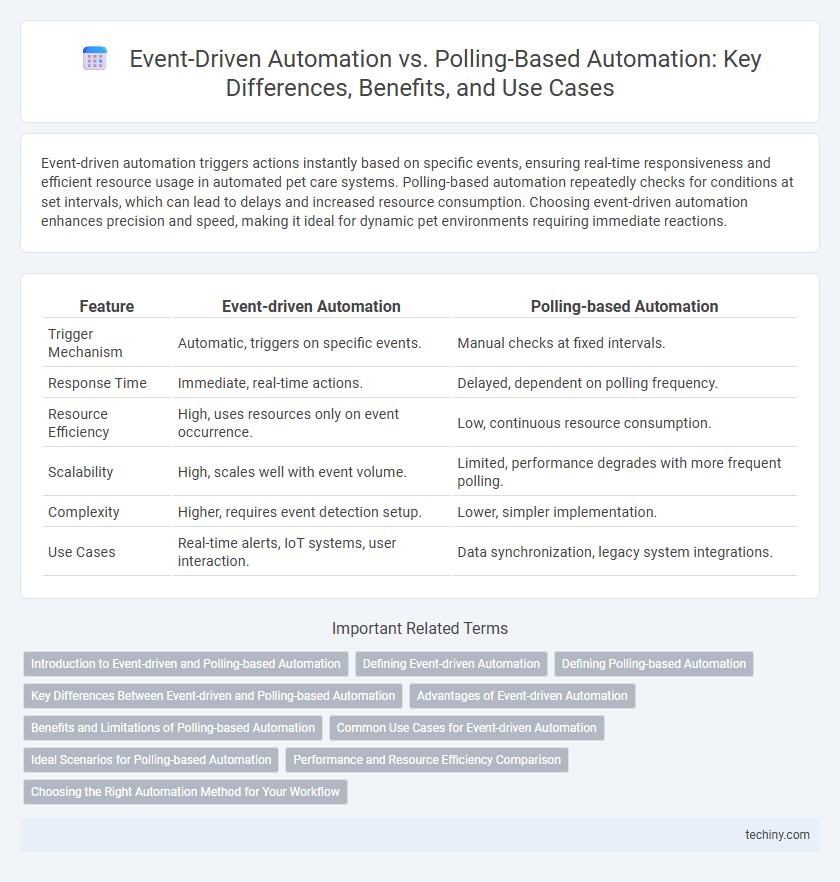Event-driven automation triggers actions instantly based on specific events, ensuring real-time responsiveness and efficient resource usage in automated pet care systems. Polling-based automation repeatedly checks for conditions at set intervals, which can lead to delays and increased resource consumption. Choosing event-driven automation enhances precision and speed, making it ideal for dynamic pet environments requiring immediate reactions.
Table of Comparison
| Feature | Event-driven Automation | Polling-based Automation |
|---|---|---|
| Trigger Mechanism | Automatic, triggers on specific events. | Manual checks at fixed intervals. |
| Response Time | Immediate, real-time actions. | Delayed, dependent on polling frequency. |
| Resource Efficiency | High, uses resources only on event occurrence. | Low, continuous resource consumption. |
| Scalability | High, scales well with event volume. | Limited, performance degrades with more frequent polling. |
| Complexity | Higher, requires event detection setup. | Lower, simpler implementation. |
| Use Cases | Real-time alerts, IoT systems, user interaction. | Data synchronization, legacy system integrations. |
Introduction to Event-driven and Polling-based Automation
Event-driven automation triggers actions instantly based on specific system events, ensuring rapid response and efficient resource utilization. Polling-based automation relies on periodic checks or intervals to detect changes, which can introduce latency and increase system overhead. Choosing between these approaches depends on the system's responsiveness requirements and resource constraints.
Defining Event-driven Automation
Event-driven automation triggers actions instantly in response to specific events or changes in data, enabling real-time processing and reducing resource consumption compared to polling-based automation. Unlike polling, which continuously checks for updates at fixed intervals, event-driven systems rely on event notifications that optimize efficiency and responsiveness. This approach is widely used in modern IT environments, IoT applications, and cloud services to achieve scalable and adaptive automation workflows.
Defining Polling-based Automation
Polling-based automation continuously checks the status of a system or device at regular intervals to detect changes or trigger actions. This method can lead to increased resource consumption and potential delays due to constant querying, making it less efficient for real-time response scenarios. Polling-based automation is widely used in legacy systems where event-driven capabilities are unavailable or impractical.
Key Differences Between Event-driven and Polling-based Automation
Event-driven automation triggers workflows immediately in response to specific events, optimizing real-time responsiveness and resource efficiency, while polling-based automation continuously checks systems at set intervals, potentially causing latency and higher resource consumption. Event-driven systems excel in scenarios requiring instant data processing and reduced operational overhead, whereas polling-based approaches are suited for environments where event generation is unpredictable or unsupported. The key differences lie in reaction speed, resource utilization, and suitability for varying application demands within automated processes.
Advantages of Event-driven Automation
Event-driven automation minimizes resource consumption by triggering processes only when specific events occur, reducing unnecessary system load compared to continuous polling. It offers faster response times and increased efficiency, allowing real-time data processing and immediate action. Event-driven systems also improve scalability and reliability by eliminating the latency and overhead often associated with polling-based automation.
Benefits and Limitations of Polling-based Automation
Polling-based automation continuously checks system status at regular intervals, enabling straightforward implementation and compatibility with legacy systems. However, it often leads to increased resource consumption and slower response times due to periodic checks rather than immediate event detection. This approach may result in redundant processing and delayed updates, limiting efficiency in time-sensitive environments.
Common Use Cases for Event-driven Automation
Event-driven automation excels in scenarios requiring real-time responsiveness, such as monitoring system alerts, triggering workflows upon user interactions, or automating security incident responses. It is commonly used in IoT device management, where instant reaction to sensor data changes is critical, and in cloud infrastructure for auto-scaling resources based on specific events. This approach minimizes latency and resource consumption compared to polling-based automation, making it ideal for dynamic environments demanding immediate action.
Ideal Scenarios for Polling-based Automation
Polling-based automation is ideal for systems where event generation is infrequent or not guaranteed, allowing consistent status checks to capture updates without missing critical information. It suits legacy systems lacking event-driven capabilities or APIs, enabling integration through periodic data retrieval. This approach works well in environments with predictable data change intervals, balancing system load while ensuring timely monitoring and response.
Performance and Resource Efficiency Comparison
Event-driven automation significantly outperforms polling-based automation in performance by reacting instantly to events, minimizing latency and reducing unnecessary processing cycles. Polling-based automation continuously checks system status at fixed intervals, leading to higher CPU usage and increased network traffic, which depletes resources inefficiently. This real-time responsiveness of event-driven systems enhances scalability and reduces operational costs compared to the periodic polling method.
Choosing the Right Automation Method for Your Workflow
Event-driven automation triggers actions instantly based on specific events, enhancing real-time responsiveness and reducing unnecessary system load, making it ideal for workflows requiring immediate reactions. Polling-based automation periodically checks for changes or updates, which can increase latency and resource consumption but suits environments where event triggers are unavailable or intermittent. Selecting the right automation method depends on factors like workflow latency tolerance, system architecture, and resource efficiency to optimize operational performance.
Event-driven Automation vs Polling-based Automation Infographic

 techiny.com
techiny.com